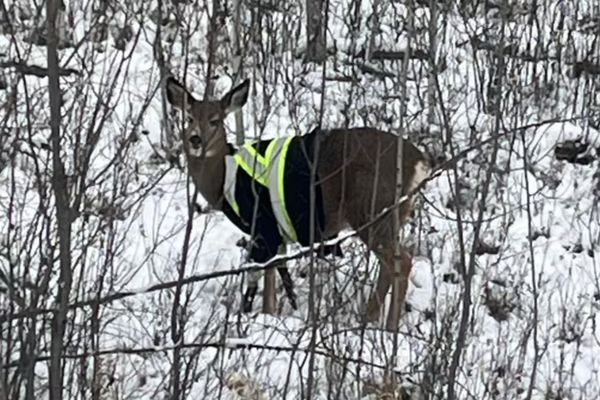
In a town of fewer than 1,000 people, it can be hard to keep a secret. And yet no one in McBride, a mountain community in British Columbia, can figure out how a local deer came to be wearing a zipped-up high-visibility jacket – or why the day-glo-clad cervid has been so hard to track down.
The mystery began on Sunday, when Andrea Arnold was driving along the snowy outskirts of McBride on Sunday and witnessed a sight so baffling she slowed her vehicle to a crawl.
“I did more than a double take, to make sure I was seeing what I was seeing,” said Arnold, a reporter for the local newspaper, the Rocky Mountain Goat.
Standing nonchalantly on the roadside was a mule deer clad in a high-visibility work jacket, its legs fitted neatly through the arm holes and the zip firmly closed.
She took two pictures before the deer disappeared into the forest, later posting the images on social media, where they drew a mixed response: some suggested that the reflective jacket might keep the deer safe along the highway, but others worried it could get snagged, possibly causing the animal to panic or injure itself.
As Arnold put it, most of the comments boiled down to three questions: “How did it get on the deer and who is responsible? And why would someone do it?”
In the days since the deer was spotted, speculation has produced few leads – or culprits.
Sgt Eamon McArthur of the BC conservation officer service told CTV News he did not want to speculate on how the jacket ended up on the cervid, although he noted: “Deer are not predisposed to wearing clothes.”
McArthur allowed that it was probable that a resident was involved, but he cautioned: “Even if you can get close enough to the wildlife to put it in a sweater or a jacket or boots or what have you, we recommend highly against that.”
Under the province’s wildlife act, it is illegal to “worry, exhaust, fatigue, annoy, plague, pester, tease or torment” an animal – a provision that would almost certainly apply to wrangling a deer into a jacket.
Conservation staff have so far been unable to locate the deer despite its distinct and unfortunate appearance, and have appealed to the public for tips.
If they eventually locate it and the animal appears in distress, McArthur says the team will remove the jacket.
But sedating an animal, especially deer, comes with its own risks. A phenomenon known as capture myopathy, which is common in deer after they are sedated, can prove fatal.
McArthur said officers are hoping the jacket falls off naturally.
“It’s astonishing [to] me that someone was able to get it on the deer without serious injury to either party,” said Arnold. “I hope the jacket comes off either on its own or with help from conservation officers before it becomes a problem for the deer.
“Treating wild animals in a domestic manner … especially putting clothes on them, is not advisable.”










